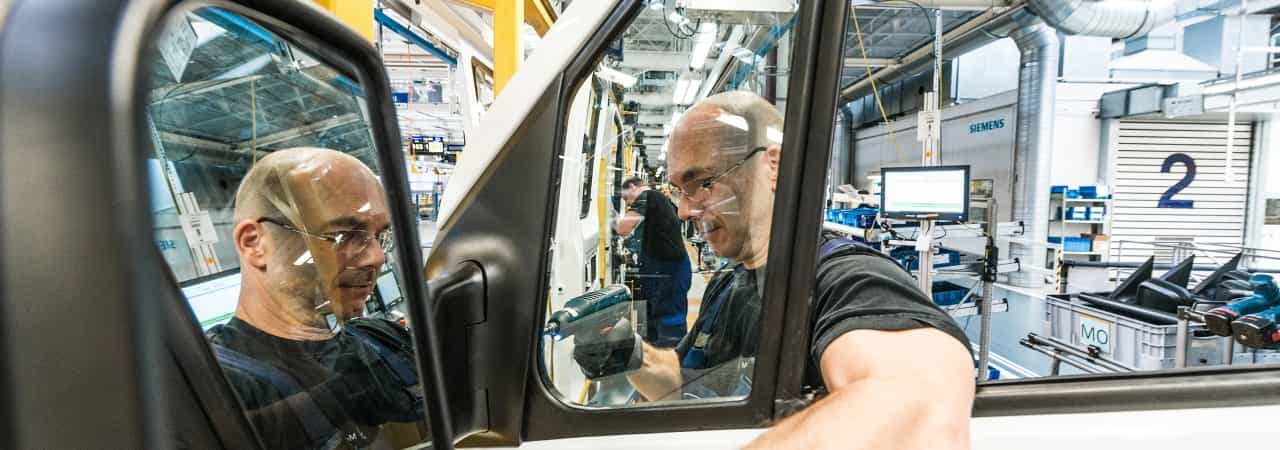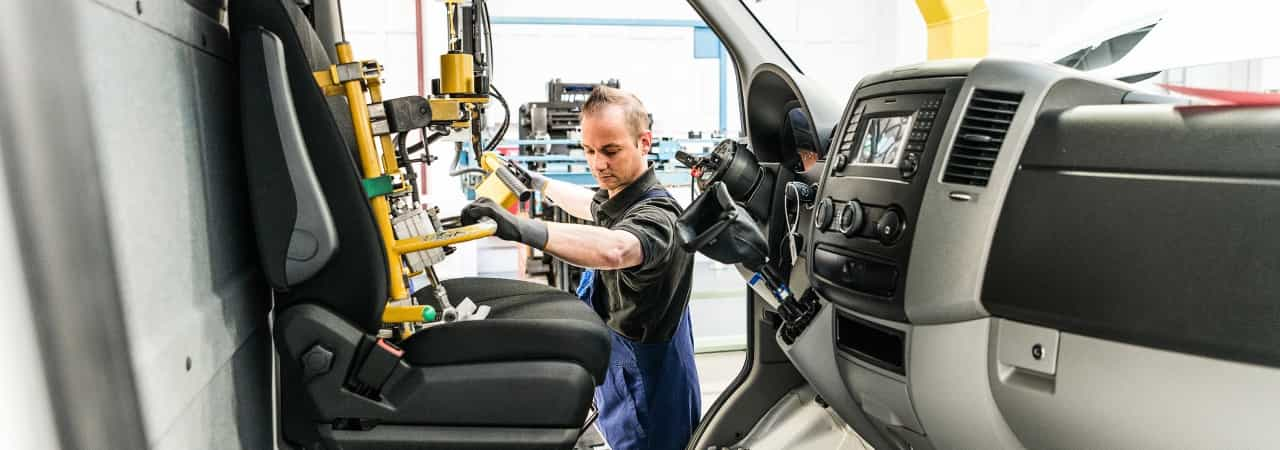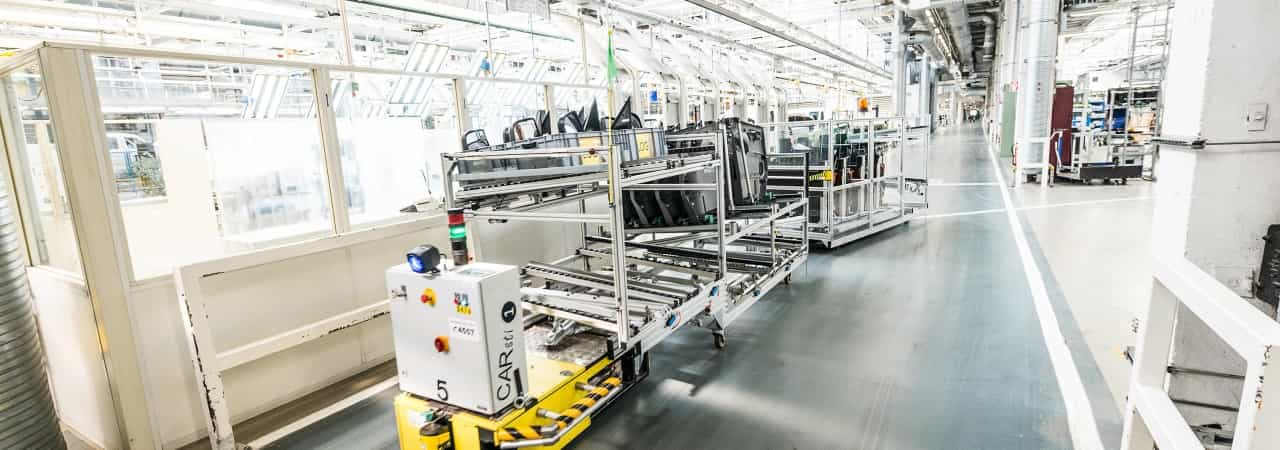RFID saves seven steps in documentation
An ambitious roadmap: By 2025, Mercedes-Benz Vans wants to complete a digital transformation of all their production sites. The goal: Managing the complexity emerging from an increased variety of models while optimising the flexibility and efficiency of the supply chain and manufacturing. The division of Daimler will spend over 200 million Euros over the next 8 years on its digitization projects.
In an interview with RFID & Wireless IoT Global, Michael Trunschke, Mercedes-Benz Vans, and Holger Seidel, Fraunhofer IFF, talk about the RFID parts identification solution at the Ludwigsfelde plant – one of the first implemented building blocks and a strategic step towards intelligent production at Mercedes-Benz Vans.
More transparency despite greater variety
Vehicles are increasingly becoming more individualised. Automobile manufacturing is fast approaching lot sizes of one – for passenger cars as well as for transporters. RFID project lead Michael Trunschke explains the increasing complexity of the worldwide Mercedes-Benz Vans production process: “There are 68 types of exterior mirrors alone, and once the new Sprinter model starts production, there will be nearly 100. For seats, the new model will expand the options by twenty percent.” These two example component groups illustrate the challenges for the production planners at Mercedes-Benz Vans when it comes to enabling a transparent manufacturing process.
The project started with an Industry 4.0 checkup
“All production processes must be transparent at all times – down to the level of every single part,” explains Holger Seidel, who led the team from Fraunhofer IFF supporting the Ludwigsfelde plant with a comprehensive Industry 4.0 checkup. “This transparency requires deploying an ideal combination of technology and IT. From here on forward, no application can be considered just by itself. The key elements for intelligent production are the combination of different technologies and the connection of data across processes and companies.”
Holger Seidel elaborates: “The checkup followed the principle 'I can't control what I can't identify'. This led to various recommended actions. For the identification of parts and documentation of assembly, RFID emerged as the best solution.”
Intensive preliminary studies for RFID use
The first phase of the checkup began in 2014 and focused on the definition of processes, the suitability of various technologies, and establishing a cost-benefit analysis. In the second phase, the solution was defined for specific processes with regards to their possible ROI. The next step was assessing its feasibility: “There were two key questions concerning the technology. One, could the read rates required for the production process be reached? And two, how could the solution be integrated into the existing IT infrastructure? Once these two questions had been answered, we began live testing at the Ludwigsfelde plant,” Holger Seidel reports.
Michael Trunschke from Mercedes-Benz Vans adds: “This detailed preliminary study was an essential requirement. This way, we could establish not only whether the technology had the required maturity, but also whether our own processes at the plant had been correctly defined and chosen. The study proved time-intensive, but it now allows us to proceed faster and with more certainty.”
The pilot started with mirrors and seats
For the RFID pilot, the project group chose the component groups exterior mirrors and seats. Michael Trunschke explains why: “Exterior mirrors and seats both possess variable production data. In addition, both are relevant to a vehicle’s security and their installation has to be documented. We have to be able to establish which precise part has been installed in which vehicle by which employee at what time.” The experiences from the pilot will be used to enable a rollout of the solution to an estimated 40 component groups.
RFID saves seven steps in documentation
“With RFID, today we can save seven steps in the documentation of the vehicle assembly,” Michael Trunschke says. Before now, employees had to either scan a barcode or enter the component number by hand at key points during the installation.
“All parts in the pilot have been RFID tagged by our suppliers. The outgoing goods department at the supplier is automated and generates digital shipping notifications for each scanned part. The goods received department at the Ludwigsfelde plant checks the products against the shipping list, as does the assembly line. During the final examination of the vehicle, all tagged parts are registered again. This way, up to four data collection points are ensuring seamless production transparency.”
Consolidating RFID know-how in the company
For Mercedes-Benz Vans, open communication and targeted information are ways of establishing how to deal with new technologies and how to spread implementation know-how. “We differentiate into three qualification groups. On the one hand, we enable the basic qualifications that every employee in assembly and logistics must possess. Today, every use case is fully visualized. Videos and brochures inform users about working with RFID.
The next step is a qualification concept for the maintenance staff responsible for the RFID technology. The third stage of the qualification concerns our in-house RFID experts: the engineers who will implement future use cases. RFID is everywhere right now: in company meetings, in training sessions, in the employee newspaper, and on the intranet. The more openness we cultivate, the greater the interest and commitment of our employees.”
Process-specific hardware deployment
Depending on the requirements of the process, both stationary antenna-reader combinations and handhelds are used. “At the goods received department, for example, stationary readers capture the components at RFID gates. The handling devices that support seat installation are also equipped with stationary readers. At the same time we have defined mobile applications together with the team from Fraunhofer IFF.
Employees, for example in the finishing area, can manually scan and register components for control purposes,” says Michael Trunschke, describing the current RFID hardware equipment at the Ludwigsfelde plant.
Labels for suppliers and data standards
As part of the RFID pilot, the suppliers involved in the project receive the RFID labels from Mercedes-Benz Vans. “Our goal is to write as little data as possible to the tags. The data links to further information in the back-end system to enable unambiguous component identification. The data on the tags complies with the recommendations 5500 and 5505 by the German Association of the Automotive Industry (VDA). The flexibility within the VDA recommendations allows us to continue using our own Daimler ISO standards, which set coordinated number ranges for specific component groups,” says Michael Trunschke.
Benefits include suppliers and after-sales
A decisive factor in whether RFID projects will succeed is successful cooperation with supplier companies, reports Holger Seidel: “The suppliers were involved in the project from an early stage. Through workshops and on-site inspections, we were able to demonstrate the possible benefits of RFID for their internal processes. This way, the suppliers were invested in the project from the beginning.” Michael Trunschke reports that RFID labels could also be used to identify parts in after-sales, for example during vehicle inspections in partner garages.
Keeping project scalability in mind
Involving the suppliers is the starting point of the project – rolling out to the other Mercedes-Benz Vans plants is the goal. “Of course, we not only had to involve our selected suppliers, but also all plants for later solution transfers. Often, several factories purchase parts from the same supplier. It would have been detrimental to the project if one plant demanded RFID labelling and the others demanded classic optical labelling,” explains Michael Trunschke.
“From the beginning of the project, we have worked in two directions. First, we test and optimize everything under real production conditions to gain experience. At the same time, we write a detailed RFID manual on all process steps. This document, which has grown to a considerable extent during the testing, is made available to colleagues in other plants in the form of a wiki.”
The time-intensive approach pays off
The technical and organizational standards of RFID use are communicated and shared with the sister plants, Michael Trunschke says: “We make sure that we do not need to develop the same solution twice. This approach is complex, but sustainable. For example, the RFID rollout required a new, division-wide IT infrastructure. It would have been much easier and faster for us to create our own IT environment here in Ludwigsfelde and to install RFID specifically for our circumstances.
But then the same would have had to take place in the other factories, which would have resulted in disproportionate cost increases. We deliberately accepted the slight delay caused by rolling out a unified IT infrastructure around the world to develop an RFID solution that works across all plants.”
New structures for the digital transformation
In order to advance the digitization of the production environment in a company that operates plants around the globe like Mercedes-Benz Vans, a uniform IT infrastructure for all locations is a basic requirement, says Michael Trunschke:
“Otherwise there will be non-transferable standalone solutions. That’s why Mercedes- Benz Vans chose the most comprehensive solution and unified the IT infrastructure worldwide. The RFID project was thus created in a very dynamic, changeable environment. This is the guideline for all digitization aspects of the project until 2025: a move away from monolithic IT systems to flexible modules that can be implemented quickly and globally. With such a ‘start-up mentality’, it will be possible to react in the shortest possible time to ever more complex manufacturing challenges in the best possible way with digital and intelligent solutions.”






